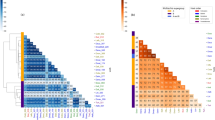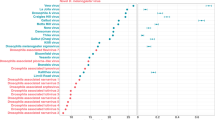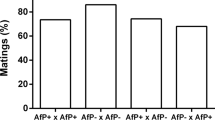Abstract
Wolbachia are intracellular bacteria found in the reproductive tissue of all major groups of arthropods1,2. They are transmitted vertically from the female hosts to their offspring, in a pattern analogous to mitochondria inheritance. But Wolbachia phylogeny does not parallel that of the host, indicating that horizontal infectious transmission must also occur3,4,5. Insect parasitoids are considered the most likely vectors, but the mechanism for horizontal transfer is largely unknown4,6,7. Here we show that newly introduced Wolbachia cross several tissues and infect the germline of the adult Drosophila melanogaster female. Through investigation of bacterial migration patterns during the course of infection, we found that Wolbachia reach the germline through the somatic stem cell niche in the D. melanogaster germarium. In addition, our data suggest that Wolbachia are highly abundant in the somatic stem cell niche of long-term infected hosts, implying that this location may also contribute to efficient vertical transmission. This is, to our knowledge, the first report of an intracellular parasite displaying tropism for a stem cell niche.
This is a preview of subscription content, access via your institution
Access options
Subscribe to this journal
Receive 51 print issues and online access
$199.00 per year
only $3.90 per issue
Buy this article
- Purchase on Springer Link
- Instant access to full article PDF
Prices may be subject to local taxes which are calculated during checkout



Similar content being viewed by others
References
Werren, J. H. & Windsor, D. M. Wolbachia infection frequencies in insects: evidence of a global equilibrium? Proc. R. Soc. Lond. B 267, 1277–1285 (2000)
Jeyaprakash, A. & Hoy, M. A. Long PCR improves Wolbachia DNA amplification: wsp sequences found in 76% of sixty-three arthropod species. Insect Mol. Biol. 9, 393–405 (2000)
Werren, J. H. & Bartos, J. D. Recombination in Wolbachia. Curr. Biol. 11, 431–435 (2001)
Vavre, F., Fleury, F., Lepetit, D., Fouillet, P. & Bouletreau, M. Phylogenetic evidence for horizontal transmission of Wolbachia in host-parasitoid associations. Mol. Biol. Evol. 16, 1711–1723 (1999)
O'Neill, S. L., Giordano, R., Colbert, A. M., Karr, T. L. & Robertson, H. M. 16S rRNA phylogenetic analysis of the bacterial endosymbionts associated with cytoplasmic incompatibility in insects. Proc. Natl Acad. Sci. USA 89, 2699–2702 (1992)
Huigens, M. E., de Almeida, R. P., Boons, P. A., Luck, R. F. & Stouthamer, R. Natural interspecific and intraspecific horizontal transfer of parthenogenesis-inducing Wolbachia in Trichogramma wasps. Proc. R. Soc. Lond. B 271, 509–515 (2004)
Heath, B. D., Butcher, R. D., Whitfield, W. G. & Hubbard, S. F. Horizontal transfer of Wolbachia between phylogenetically distant insect species by a naturally occurring mechanism. Curr. Biol. 9, 313–316 (1999)
Grenier, S. et al. Successful horizontal transfer of Wolbachia symbionts between Trichogramma wasps. Proc. R. Soc. Lond. B 265, 1441–1445 (1998)
Kang, L. et al. Superinfection of Laodelphax striatellus with Wolbachia from Drosophila simulans. Heredity 90, 71–76 (2003)
Rigaud, T., Pennings, P. S. & Juchault, P. Wolbachia bacteria effects after experimental interspecific transfers in terrestrial isopods. J. Invertebr. Pathol. 77, 251–257 (2001)
Zhang, Y. & Kalderon, D. Hedgehog acts as a somatic stem cell factor in the Drosophila ovary. Nature 410, 599–604 (2001)
Margolis, J. & Spradling, A. Identification and behaviour of epithelial stem cells in the Drosophila ovary. Development 121, 3797–3807 (1995)
Fuchs, E., Tumbar, T. & Guasch, G. Socializing with the neighbors: stem cells and their niche. Cell 116, 769–778 (2004)
Ohlstein, B., Kai, T., Decotto, E. & Spradling, A. The stem cell niche: theme and variations. Curr. Opin. Cell Biol. 16, 693–699 (2004)
Li, L. & Xie, T. Stem cell niche: structure and function. Annu. Rev. Cell. Dev. Biol. 21, 605–631 (2005)
Dobson, S. L. et al. Wolbachia infections are distributed throughout insect somatic and germ line tissues. Insect Biochem. Mol. Biol. 29, 153–160 (1999)
Min, K. T. & Benzer, S. Wolbachia, normally a symbiont of Drosophila, can be virulent, causing degeneration and early death. Proc. Natl Acad. Sci. USA 94, 10792–10796 (1997)
Cheng, Q. et al. Tissue distribution and prevalence of Wolbachia infections in tsetse flies, Glossina spp. Med. Vet. Entomol. 14, 44–50 (2000)
Mcgraw, E. A. & O'Neill, S. L. Wolbachia pipientis: intracellular infection and pathogenesis in Drosophila. Curr. Opin. Microbiol. 7, 67–70 (2004)
Hadfield, S. J. & Axton, J. M. Germ cells colonized by endosymbiotic bacteria. Nature 402, 482 (1999)
Veneti, Z., Clark, M. E., Karr, T. L., Savakis, C. & Bourtzis, K. Heads or tails: host-parasite interactions in the Drosophila-Wolbachia system. Appl. Environ. Microbiol. 70, 5366–5372 (2004)
Decotto, E. & Spradling, A. C. The Drosophila ovarian and testis stem cell niches: similar somatic stem cells and signals. Dev. Cell 9, 501–510 (2005)
Frydman, H. M. & Spradling, A. C. The receptor-like tyrosine phosphatase lar is required for epithelial planar polarity and for axis determination within Drosophila ovarian follicles. Development 128, 3209–3220 (2001)
Ferree, P. M. et al. Wolbachia utilizes host microtubules and dynein for anterior localization in the Drosophila oocyte. PLoS Pathogens 1, e14 (2005)
Mcgraw, E. A., Merritt, D. J., Droller, J. N. & O'Neill, S. L. Wolbachia density and virulence attenuation after transfer into a novel host. Proc. Natl Acad. Sci. USA 99, 2918–2923 (2002)
Lin, H. & Spradling, A. C. Germline stem cell division and egg chamber development in transplanted Drosophila germaria. Dev. Biol. 159, 140–152 (1993)
Clarkson, M. & Saint, R. A. His2AvDGFP fusion gene complements a lethal His2AvD mutant allele and provides an in vivo marker for Drosophila chromosome behaviour. DNA Cell Biol. 18, 457–462 (1999)
Acknowledgements
We thank G. Deshpande, T. Schupbach and A. Nouri for comments on the manuscript; A. Spradling, D. D. Barbosa, P. Ferree and W. Sullivan for stocks and reagents; B. Burdine for help with injection experiments; J. Goodhouse for microscopy assistance; and A. Basile, and the Wieschaus and Schupbach laboratory members for support during the realization of this work. Author Contributions H.M.F. planned the project. H.M.F. and E.W. designed experiments. H.M.F. and J.M.L. performed experiments. D.N.R. wrote the image analysis software and statistical analysis. H.F. and E.W. contributed reagents and materials. H.M.F. wrote the paper. E.W., D.N.R. and J.M.L. edited the paper.
Author information
Authors and Affiliations
Corresponding author
Ethics declarations
Competing interests
Reprints and permissions information is available at npg.nature.com/reprintsandpermissions. The authors declare no competing financial interests.
Supplementary information
Supplementary Notes
This file contains Supplementary Figures 1 and 2, Supplementary Table 1, Supplementary Methods and Supplementary Video Legend. This file also contains additional references. (PDF 2145 kb)
Supplementary Video
Volumetric reconstruction from confocal microscopy of the germarium with a single infected SSCN. This movie shows a rotation of this germarium, allowing comparison of the levels of Wolbachia in the follicle cells between the infected and the uninfected sides. (MOV 3269 kb)
Rights and permissions
About this article
Cite this article
Frydman, H., Li, J., Robson, D. et al. Somatic stem cell niche tropism in Wolbachia. Nature 441, 509–512 (2006). https://doi.org/10.1038/nature04756
Received:
Accepted:
Issue Date:
DOI: https://doi.org/10.1038/nature04756
This article is cited by
-
Wolbachia-density variation in weevils of the tribe Naupactini (Coleoptera, Curculionidae)
Symbiosis (2024)
-
The cellular lives of Wolbachia
Nature Reviews Microbiology (2023)
-
Environmental Temperature, but Not Male Age, Affects Wolbachia and Prophage WO Thereby Modulating Cytoplasmic Incompatibility in the Parasitoid Wasp, Habrobracon Hebetor
Microbial Ecology (2022)
-
New host-parasitoid interactions in Naupactus cervinus (Coleoptera, Curculionidae) raise the question of Wolbachia horizontal transmission
Symbiosis (2022)
-
Supergroup F Wolbachia in terrestrial isopods: Horizontal transmission from termites?
Evolutionary Ecology (2021)
Comments
By submitting a comment you agree to abide by our Terms and Community Guidelines. If you find something abusive or that does not comply with our terms or guidelines please flag it as inappropriate.



